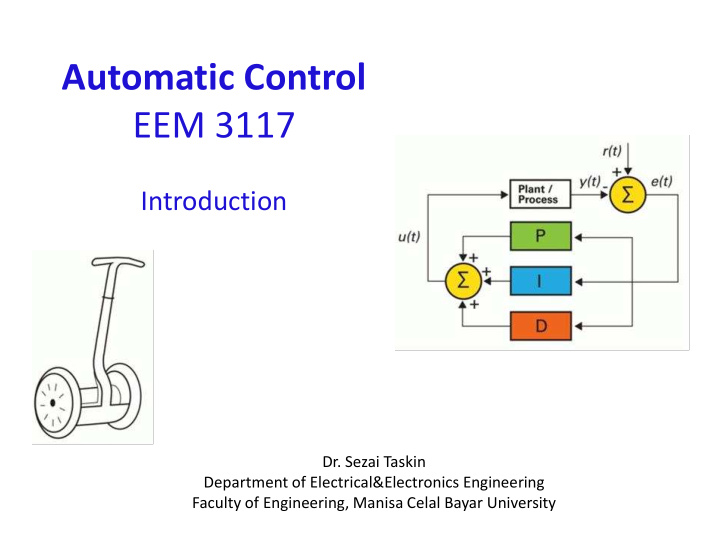



Automatic Control EEM 3117 Introduction Dr. Sezai Taskin Department of Electrical&Electronics Engineering Faculty of Engineering, Manisa Celal Bayar University
Instructor • Instructor: Sezai Taskin, Ph.D Prof. Department of the Head • Classes and office hours: Every Tuesday • Email: sezai.taskin@cbu.edu.tr • Lab. Assistant: M. Ali Ustuner, PhD Student Slides 1: Introduction 2
Course Materials Slides: Will be available online. http://sezaitaskin.cbu.edu.tr/ Text Books: K. Ogata, Modern Control Engineering Ibrahim Yuksel, Otomatik Kontrol References: • N. Nise, Control Systems Engineering, John Wiley & Sons, Inc., 2011. • R.C. Dorf and R.H. Bishop, Modern Control Systems, 11 th ed. Pearson Education Inc., 2008. Slides 1: Introduction 3
Grading • Class participation, quizzes and assignments • Midterm exam (30%) • Quiz (10%) • Lab. Reports (10%) • Final examination (50%) Slides 1: Introduction 4
Why to study “Automatic Control”? • The study of automatic control is essential for students pursuing degrees in many engineering disciplines (mechanical, electrical, structural, aerospace, biomedical, or chemical). • Applications of automatic control include, but not limited to, aircraft, robots, civil engineering structures, process control, …., etc. • Automatic control has played a vital role in the advance of engineering and science . Slides 1: Introduction 5
What is “Control”? • Make some object (called system, or plant ) behave as we desire. • Imagine “control” around you! Room temperature control Car driving Voice volume control “Control” (move) the position of the pointer etc. Slides 1: Introduction 6
What is “Automatic Control”? • Not manual! • Why do we need automatic control? Convenient (room temperature, laundry machine) Dangerous (hot/cold places, space, bomb removal) Impossible for human (nanometer scale precision positioning, work inside the small space that human cannot enter, huge antennas control, elevator) It exists in nature. (human body temperature control) High efficiency (engine control) • Many examples of automatic control around us Slides 1: Introduction 7
Example: temple doors opened by fire on an altar Heron of Alexandria (c. 10 – 85 AD) When a fire is lit, the air in the altar is heated and, as it expands, it enters a hollow sphere full of water. Due to the rising pressure in the sphere, some of the water is displaced into the bucket. As the bucket becomes more heavy, it is lowered, opening the doors of the temple Heron of Alexandria was a mathematician, physicist and engineer who lived around 10 –85 AD. He taught at Alexandria’s Musaeum and wrote many books on Mathematics, Geometry and Engineering, which were in use till the medieval times. His most important invention was the Aeolipile, the first steam turbine. Other inventions include automated machines for temples and theaters, surveying instruments, and military machines and weapons. Slides 1: Introduction 8
Example: vending machine Heron's COIN automat Slides 1: Introduction 9
Example: laundry machine A laundry machine washes clothes, by setting a program. Program setting Laundry Washed clothes (Input) Machine (Output) A laundry machine does not measure how clean the clothes become. Control without measuring devices (sensors) are called open-loop control. Slides 1: Introduction 10
Open-loop control systems Advantages: • Simple construction and ease of maintenance. • There is no stability concern. • Convenient when output is hard to measure or measuring the output precisely is economically not feasible. (For example, in the washer system, it would be quite expensive to provide a device to measure the quality of the washer's output, cleanliness of the clothes). Disadvantages: • Disturbances and changes in calibration cause errors, and the output may be different from what is desired. • Recalibration is necessary from time to time. Slides 1: Introduction 11
Closed-loop (feedback) control In this approach, control action is dependent on the output. Slides 1: Introduction 12
Example: autopilot mechanism Its purpose is to maintain a specified airplane heading, despite atmospheric changes. It performs this task by continuously measuring the actual airplane heading, and automatically adjusting the airplane control surfaces so as to bring the actual airplane heading into correspondence with the specified heading. Slides 1: Introduction 13
Example: antenna azimuth Slides 1: Introduction 14
Example: antenna azimuth Slides 1: Introduction 15
Basic elements of control loop Disturbance Error Ref. Input Output Controller Actuator Plant Sensor The role of the controller is to make the output following the reference in a “satisfactory” manner even under disturbances. Slides 1: Introduction 16
playing sport Example: Better Actuators Better Sensors Provide more Muscle Provide better Vision Better Control Provides more finesse by combining sensors and actuators in more intelligent ways Slides 1: Introduction 17
Course goals Disturbance Error Ref. Input Output Controller Actuator Plant Sensor Implementation Modeling Mathematical Controller model Design Analysis Slides 1: Introduction 18
Procedure Slides 1: Introduction 19
Summary • Introduction: Control essentiality Examples of control systems Open loop versus closed loop control systems • Next Lecture: Laplace Transformation Review Slides 1: Introduction 20
Recommend
More recommend